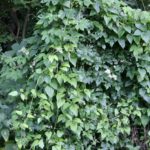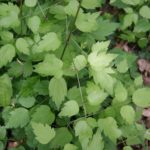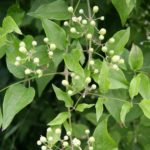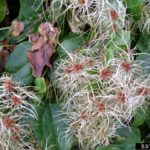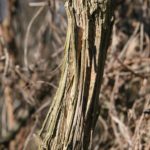Gallery:
- Old man’s beard (Photo: Robert Vidéki, Doronicum Kft., Bugwood.org)
- Old man’s beard leaves (Photo: Robert Vidéki, Doronicum Kft., Bugwood.org)
- Old man’s beard buds (Photo: Robert Vidéki, Doronicum Kft., Bugwood.org)
- Old man’s beard flowers (Photo: Robert Vidéki, Doronicum Kft., Bugwood.org)
- Old man’s beard in seed (Photo: Jan Samanek, Phytosanitary Administration, Bugwood.org)
- Old man’s beard mature vine (Photo: Robert Vidéki, Doronicum Kft., Bugwood.org)
Common names:
Old man’s beard, traveler’s joy
Scientific Name:
Clematis vitalba
Description:
Old man’s beard is a deciduous, perennial climbing vine in the Ranunculaceae (buttercup) family. It was introduced as an ornamental plant, but it has spread rapidly across western Oregon, especially in the north end of the Willamette Valley. This plant is also known as “traveler’s joy”, as its rapidly growing vines can grow 10 feet a year, and can reach 90 feet in length. The greenish-white flowers grow in clusters of 3 to 22. The leaves are opposite and compound with 5 leaflets (sometimes 3). The seed heads are feathery and white, giving the plant its name. New stems are deeply ridged, while the older bark is gray and stringy. It produces large quantities of seeds and can also spread by stem fragmentation.
Life cycle:
Height of mature plants
Up to 90 feet in length
Flower color:
greenish-white to creamy-white
Bloom time:
Summer
Look-a-likes:
Old man’s beard looks similar to native varieties of clematis. One native, C. ligusticifolia only grows to about 20 feet in length and has 5-7 leaflets, while old man’s beard grows up to 90 feet in length and has 5 leaflets (sometimes 3). The other native look alikes, C. lasiantha and C. pauciflora, flower from January to June, while old man’s beard flowers from June to September. Old man’s beard is also sometimes confused with ivy. However, ivy is evergreen and does not have compound leaves like old man’s beard.
Habitat:
Old man’s beard typically grows in sunny disturbed areas, however, it can also grow in part sun to full shade. This plant can be found in forest margins and gaps, riparian areas, fence lines, and roadsides. It can tolerate sandy, loamy, or clay soils, though it prefers well drained, moist soil.
Impacts:
The rapidly growing vines of old man’s beard can blanket the ground and can also cover trees and shrubs, blocking out light for those plants and causing trees to fall. Once a tree collapses, the plant continues to grow along the ground in layers several feet thick, preventing native plant regeneration below it.
Noxious Weed Listing:
- WeedWise: Maintenance
- State of Oregon: Class B
- State of Washington: Class C
- Four County CWMA: Class B
- Columbia Gorge CWMA: Class C
Origin:
Asia, Europe, and North Africa
Links:
Washington Noxious Weed Profile
CABI Invasive Species Compendium
Global Invasive Species Database
Columbia Gorge CWMA- Best Management Practices- Old Man’s Beard
Clematis vitalba – Weed Report: Weed Control in Natural Areas of the Western United States
King County Noxious Weed Control Program Weed Alert- Old Man’s Beard

